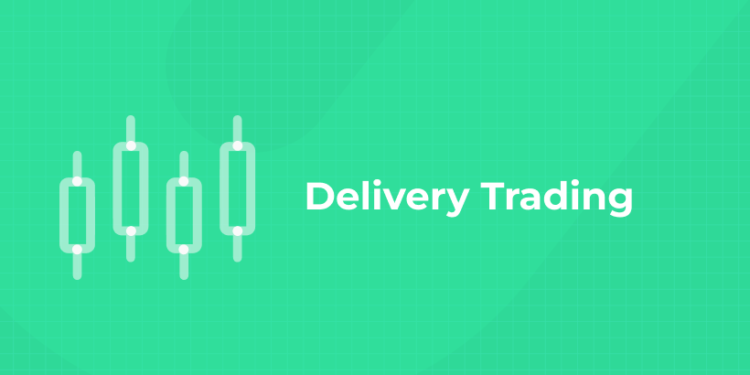Table of Contents
Introduction
In a world where there are still traders that seek to make overnight profits from lightning-fast buying and selling, it is delivery trading where one can build sustainable wealth. Faced with the test of time, delivery trading has created more millionaires than any other form of stock market investing where one can follow in the footsteps of Warren Buffett and Benjamin Graham. You aren’t just simply doing trades for when you delivery trade; you are essentially becoming a part owner in businesses that can indeed grow over the long term.
Learn SEBI Compliant Stock Market Course!
Delivery trading is the foundation of stock market investing where you actually own shares for extended periods. Unlike the hectic world of day trading, this approach allows you to benefit from capital growth and corporate actions like dividends, creating multiple returns from one investment decision. As we get into this guide you’ll see why delivery trading might be the key to achieving your financial goals.
How Does Delivery Trading Work?
Delivery trade is a simple and powerful investment strategy in which one has to buy shares of a company and hold the same in his demat account for the long-term period. Unlike intraday trading, where traders square off positions within the same day, here an individual actually owns the shares.
Here’s how it works:
- Buying Shares: You buy shares of a company through your trading account.
- Holding Period: You hold the shares for days, months or even years depending on your investment goals.
- Selling Shares: When you decide to sell, the shares are transferred from your demat account to the buyer’s account and the proceeds are credited to your bank account.
The difference between delivery trading and other types of trading lies in the ownership of shares. Delivery trading makes you a shareholder of the company. That is, you are entitled to dividends and voting rights as well as other privileges.
Learn Stock Marketing with Share Trading Expert! Explore Here!
Advantages of Delivery Trading
Delivery trading has several benefits that make it an attractive option for long term investors:
- Ownership of shares: You will own the shares, thus the benefits from dividend, stock split, and bonus issues.
- Low risk: In case you’re not leveraged, then you are risking what you have in terms of invested amount.
- Long term growth: Delivery trading is a ride through long term growth of good companies.
- Tax Advantages: LTCG on equity shares held above one year are charged at lower rate in India i.e 12.5% above ₹1 lakh
- Less Stress: The delivery trading is not the type of intraday trade as delivery trade requires not constant follow-up of market conditions.
Disadvantages of Delivery Trade
Though delivery trading has its benefits, it has its downsides:
- Capital Lock-In: Your money is stuck in the shares till you decide to sell, which can limit your liquidity.
- Market Risk: The value of your shares can go up or down based on market conditions and there is no guarantee of returns.
- Opportunity Cost: If the market moves against you, you might miss out on better investment opportunities.
- Brokerage and Charges: Though lower than intraday trading, brokerage and other charges can still eat into your profits.
How to Start Delivery Trading?
Starting delivery trading is easier than you think. Now, here is how one can go about it, step by step:
- Open a demat and trading account. There are good brokers; open a demat and trading account with one.
- KYC. Carry out the KYC process by submitting documents like PAN card, Aadhaar card, and so on.
- Link your bank account to obtain smooth fund transfers for trading purposes.
- Look for and choose stocks: Fundamental and technical analysis help to identify good stocks that would help in growing.
- Order Entry: Log into your trading account, select the stock, and order a buy-against-delivery.
- Track Your Investments: Track your portfolio and keep up with the latest news of the company and the market scenario.
Brokerage & Charges in Delivery Trade
Grasping the expenses associated with delivery trading is essential for optimizing your profits. Here’s a summary of the fees:
Brokerage: The majority of brokers levy a standard fee or a portion of the trade value for executed trades. Certain discount brokers provide no brokerage fees on delivery trades.
Securities Transaction Tax (STT): A fee of 0.1% of the overall transaction value is applied when you sell stocks.
Goods and Services Tax (GST): GST is levied on brokerage and additional fees at a rate of 18%.
Stamp Duty: This is a charge applied by the state on the purchase of shares.
DP Fees: Individuals with demat accounts might face DP (Depository Participant) fees for maintaining shares in their demat account.
Difference between Intraday Trading and Delivery Trading
1: What is a stock?
Intraday trading and delivery trading are two different types of trading in the stock market that differ in the time frame.
| Feature | Intraday Trading | Delivery Trading |
|---|---|---|
| Timeframe | The positions are squared off on the same day of buying (bought securities are sold and sold securities are repurchased) | There is no limited timeframe. The stocks can be held for days, months or years |
| Leverage | Brokers provide a high leverage to buy intraday positions | Emerging facility can be availed by paying interest to the broker |
| Ownership | There is no actual transfer of ownership | The stocks are delivered to the buyer’s demat account and are owned by the investor – making them a shareholder of the company |
| Analysis | The stocks are bought based on price, volume actions and some short term technical analysis tools, which has limitation due to very shorter time frame. | Investors buy the stocks based on fundamental or technical analysis, using better and more reliable tools for greater sustainability and reliability. |
| Risk | High risk due to leverage and volatility in prices | Long-term market and company-specific risks |
| Transaction costs | High (due to the frequency of trades) | Low |
| Profits | Gained from short-term price changes | Gained from long-term capital appreciations and dividends |
| Tax Liability | Gets treated as your salary or business income | Short-Term Capital gain tax 20%, if held for less than 1 year. Long Term Capital gain tax at 12.5% without indexation benefit, if held for more than 1 year. |
Best Strategies for Delivery Trading
To be successful in delivery trading you need a good strategy. Some strategies:
- Value Investing: Investors seek invaluable shares that are currently underpriced, yet fundamentally strong, with significant growth prospects for the long run.
- Dividend Investing: Investing in companies having a track record of dividend payouts.
- Growth Investing: Invest in companies with high growth potential even if they are overvalued.
- SIP in Stocks: Invest a fixed amount in stocks at regular intervals using systematic investment plan (SIP).
- Sector Rotation: Rotate your investments across different sectors based on economic cycles and market trends.
Conclusion
Delivery trading is a proven way to create long term wealth in the markets. By reading this guide you’re ready to start your journey as a serious investor. Remember success in delivery trade is about patience, discipline and continuous learning.
Start your delivery trading journey with realistic expectations and a commitment to following sound investment principles. Build a portfolio of quality companies, reinvest your dividends and let compounding work for you. Over time and with dedication delivery trade will help you achieve your financial goals and sleep better.
Your success is waiting. Start now, apply these principles and let your wealth grow over time with the time tested approach of delivery trade.
| Achieve Financial Freedom with these courses? | |
| Stock Market Trading Course | |
| Forex Trading Course | |
| Mutual Funds Course |
SEBI-Compliant Stock Market Training
Trusted, practical strategies to help you grow with confidence. Enroll now and start investing the right way.
Know moreFrequently Asked Questions
What is delivery trading in stock market?
Delivery trading is old school investment where you own physical shares by holding them in your demat account for days to years. Unlike intraday trading, delivery trading is all about long term value appreciation and corporate benefits like dividends.
How is delivery trading different from intraday trading?
The main difference is holding period and ownership. In delivery trading you take physical possession of shares in your demat account and can hold them forever. In intraday trading you need to close your positions before the market closes on the same day and no ownership is transferred.
What is the minimum amount required to start delivery trading?
There is no fixed minimum amount but it’s recommended to start with at least ₹10,000-20,000 to build a decent portfolio. The actual amount depends on the share prices of the companies you are interested in and your diversification goals.
How long should I hold stocks in delivery trading?
Holding period varies based on your investment strategy and the company’s performance. Typically successful delivery traders hold stocks for several months to years so that their investment thesis plays out and they benefit from long term growth.
Do I need a demat account to do delivery trading?
Yes, for delivery trading you require a demat account as it’s the place where your shares are held electronically. To execute delivery trade you would require two accounts: a trading account and linked demat account.
How do I receive dividends in delivery trading?
Companies automatically credit the dividends to your linked bank account once they declare them. You should have held the shares on the record date that the company specifies to receive dividends.
What is T+2 settlement in delivery trading?
T+2 refers to the settlement cycle in which shares are credited to your demat account two working days after the execution of a trade (T+2). In other words, if you purchase shares on Monday, then it will be credited to your account by Wednesday.
How do I select stocks for delivery trading?
Stock selection should be based on Fundamental analysis that includes the assessment of such factors as company financials, business model, management quality, industry growth potential and its advantages of competitiveness. Emphasize those companies that have high growth potential and have sustainable business models.
How much brokerage will be charged for delivery trade?
Brokerage charges for delivery trading are usually less than intraday trading, typically ranging from 0.1% to 0.5% of the trade value. Many brokers offer flat fee structures or discounted rates for delivery trades.













